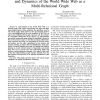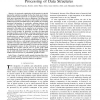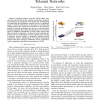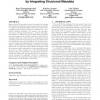1077 search results - page 62 / 216 » Learning network structure from passive measurements |
SOCIALCOM
2010
13 years 5 months ago
2010
A representation of the World Wide Web as a directed graph, with vertices representing web pages and edges representing hypertext links, underpins the algorithms used by web search...
BIBM
2008
IEEE
14 years 2 months ago
2008
IEEE
Identifying functionally important sites from biological sequences, formulated as a biological sequence labeling problem, has broad applications ranging from rational drug design ...
TNN
1998
13 years 7 months ago
1998
—A structured organization of information is typically required by symbolic processing. On the other hand, most connectionist models assume that data are organized according to r...
INFOCOM
2005
IEEE
14 years 1 months ago
2005
IEEE
— Disruption-Tolerant networks (DTNs) differ from other types of networks in that capacity is exclusively created by the movements of participants. This implies that understandin...
KDD
2010
ACM
13 years 11 months ago
2010
ACM
Many social Web sites allow users to annotate the content with descriptive metadata, such as tags, and more recently to organize content hierarchically. These types of structured ...




